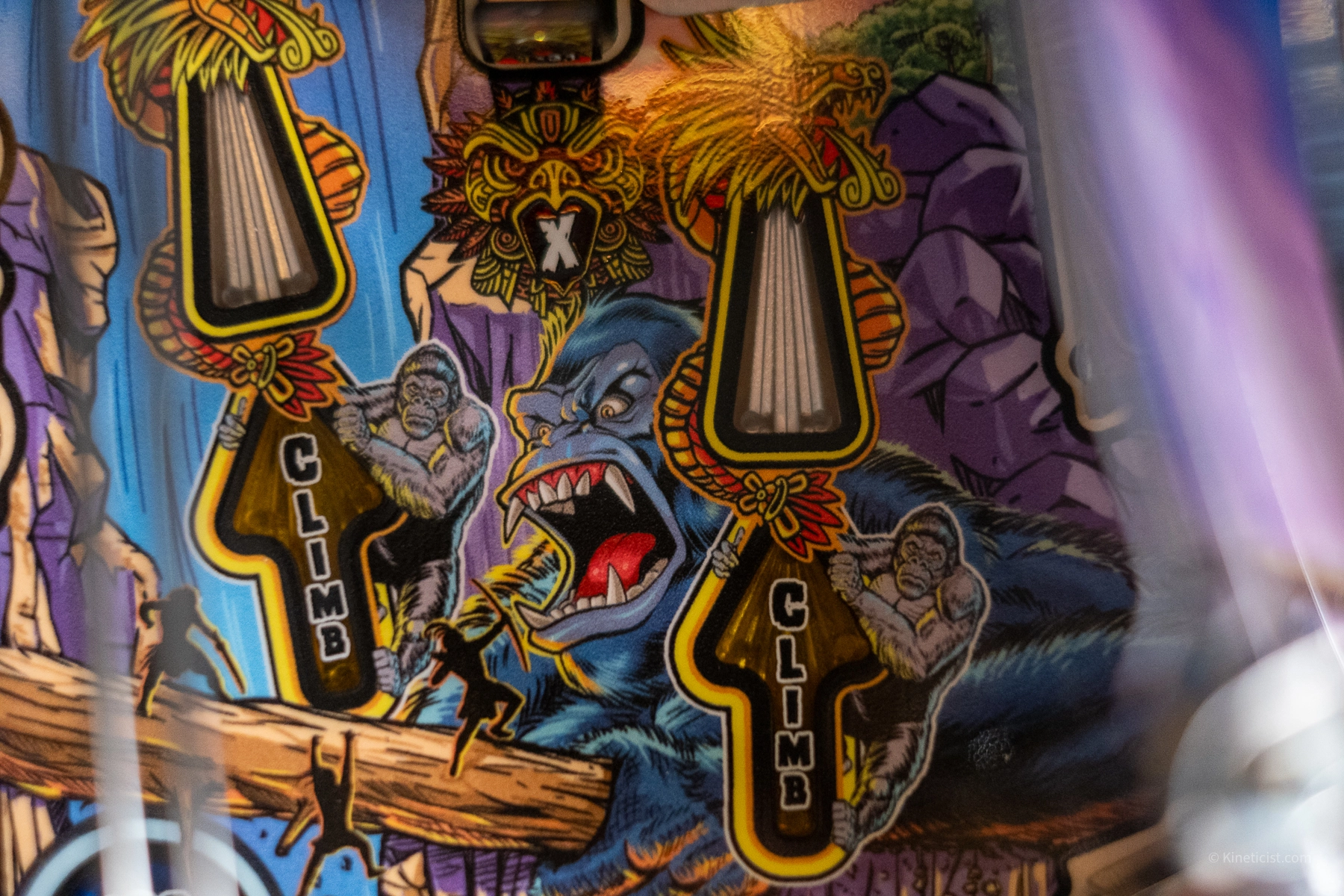Review: No Surprise, King Kong Is Another Great Keith Elwin Game

Image Gallery
I find Keith Elwin's games hard to review.
On launch, you’re almost guaranteed to have a feature-complete game that’s fun to shoot and features elements you’ve never seen in pinball before.
It’s like trying to review a great piece of cinema. The first watch is about understanding the vibes and seeing if the film checks a few important boxes that signal if it’s worth engaging with further. Assuming it checks those first few boxes, it’s the repeat viewings where you start to pick up on the layered nuances and subtleties that turn good art into great art.

This dynamic is almost always at play when it comes time to evaluate an Elwin game. For his seventh major release for Stern Pinball, it’s become expected that an Elwin game will check most of the major boxes on the vibe check phase. But I find that his games don’t truly shine until the code develops a bit further, and I get a lot more time on the machine to better understand all the finer gameplay details.
Last week, I had the opportunity to visit Stern Pinball for their King Kong media event, where I got some hands-on time with the release. There, I made it a point to spend as much time as I could playing the game across both the Pro and Premium versions (the LE trim was not made available to us at the time).

Even after a dozen or so plays, I still only feel I’ve scratched the surface of what’s inside this release and what might be possible as the code matures.
But I can say confidently that King Kong passed the vibe check phase, and I’m excited to explore it more in the future.
Layout and Shot Flow

In a way, I almost feel bad for Elwin and team, because in trying to evaluate one of his games, you’re almost never asking if the game is good. That the game will be good is practically a given, so it’s more about asking how great the game is. Is King Kong Godzilla great, or JAWS great?
In playing King Kong for the first time, I kept coming back to the idea that pinball fans are spoiled to have someone like Keith Elwin as a designer in this hobby. Were King Kong released by any other working designer, it might be in the discussion for that designer’s best of all time. For Elwin, however, it’s another day in the office, and that colors the experience to an extent.
There’s a lot I really enjoy about this game. Elwin makes great use of space to introduce all kinds of novel ball paths, shot returns, combo opportunities, and areas to explore. This is illustrated well by the game’s upper-left section of the playfield, with its three levels of ball paths, plus a mini-flipper, player-controlled diverter, and drop target bank.
He also works in callbacks to noted favorites like Congo and 1970s EMs like Atlantis with the River zig-zag return and its use of serial rollovers.
.webp)
The Kong punch-back target in the upper right corner (below the Kong mech) is something I’ve never seen in pinball before and sets up a fast-react feed to the upper-right flipper for a supremely satisfying shot to the Biplane ramp, which features some of Elwin's signature swirly wireform work.

While satisfying to hit, I found the Biplane ramp tough to nail consistently, alongside the Gong entrance (which is an important shot in this table) and the sweepable drops, where I could rarely get the angle off the right flipper dialed in enough to hit more than a drop or two at a time.
On the Pro version of the table, the Gong entrance was particularly tough to hit, as I’d frequently encounter frustrating rejects, and even dead-on shots would seemingly hit the protective padding behind the scoop and bounce back out.

Starting King Kong multiball on the Premium is a fun moment, but it requires enough steps (multiple completions of the drop targets, plus locking balls by shooting the center ramp) that I could see many casual players never experiencing it.
Code Depth & Theme Integration

The code, helmed by Elwin team regular Rick Naegele, seems quite fleshed out (~.80 when I played) for a new release. Players already have a selection of modes and multiballs to play through, plus a whole bunch of interesting combos and skill shots to learn.
I didn’t spend a lot of time evaluating the game’s animations or sound package in fine detail, but both seemed about on par for Stern releases over the last year or so. Both are maybe a little more impressive when considering that the production teams had to create these assets with no licensed material to pull from.
The art package functions similarly. The playfield art was largely created by Greg Freres, based on work that Kevin O’Connor did on the original Data East King Kong prototype from 1990. Jeremy Packer joined the project later on and is primarily responsible for the game’s cabinet and translite art.

The pinball community was quick to deride the game for its use of color (specifically, too much of it), but I didn’t mind that in person. While the playfield artwork is on the busier side, I did find myself appreciating the detail work in the illustrations that are difficult to see on a live stream or a product photo, but are fun to comb over in person. I think the game’s heavy use of inserts will be important as the code develops, as most seemed tied to specific progression mechanics or modes that players will want to see at a glance.
No Licenses

Even though King Kong trades on the name of a famous media franchise, it is based on the character and world of the 1932 novel, which is in the public domain. This makes King Kong a fully non-licensed game, and Stern’s first major unlicensed release since 2001’s High Roller Casino. With this in mind, Stern’s creative team set out to put their own unique spin on the King Kong story, which, among other things, included choosing a color palette that would stand out among other notable depictions of the character.
This would prove to be both a blessing and a curse for the team. On the one hand, with no licensor restrictions, they could create anything they wanted. On the other hand, they could create anything they wanted! As a creative team, if you’ve mostly traded on building complementary products for existing stories and characters, where do you start if you have to build out a world from square one?

With this in mind, I think what was created for King Kong is admirable, and with this exercise complete, I could see Stern leaning into more original-ish storytelling that might see them creating more original gameplay experiences within more recognizable IP worlds. For example, what if the rumored upcoming Star Wars game wasn’t one based on an existing property, but instead was an original story for pinball, set in the Star Wars universe?
Early Verdict
.webp)
I digress. King Kong is a great Keith Elwin game. How great exactly is open to interpretation. Like most of Stern’s recent releases, the Pro trim offers a compelling experience, which I found myself preferring over some of the bells and whistles found in the Premium.
Whereas I thought a release like JAWS would ultimately settle in mid-tier Elwin range (somewhere between Avengers and Iron Maiden), I do think King Kong will be an upper-tier Elwin game, possibly giving the top-ranked Godzilla some needed competition. But this is what we’ve come to expect from Keith Elwin games, and we’re all supremely spoiled for it.








.webp)

